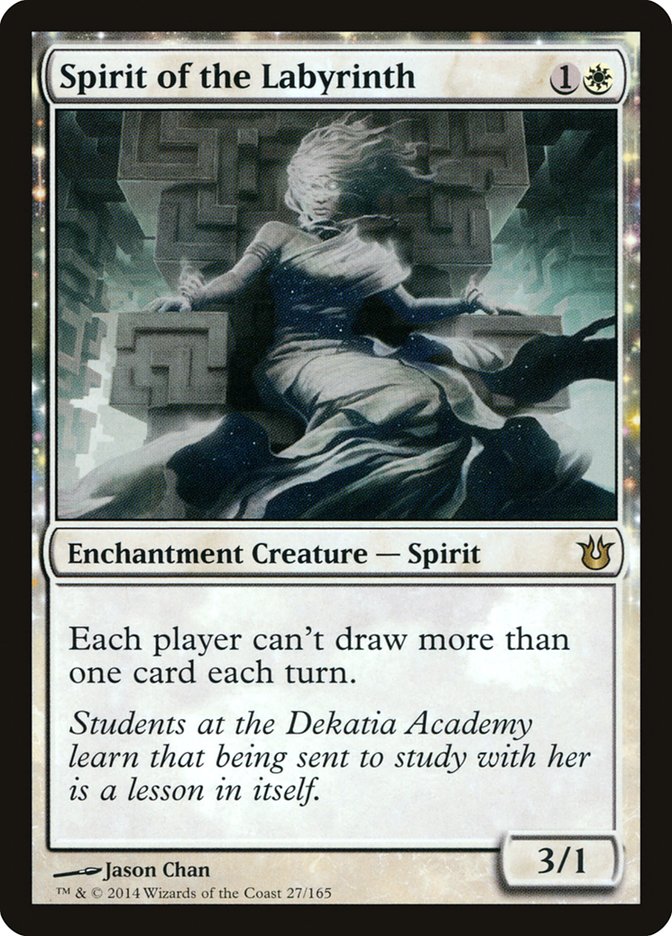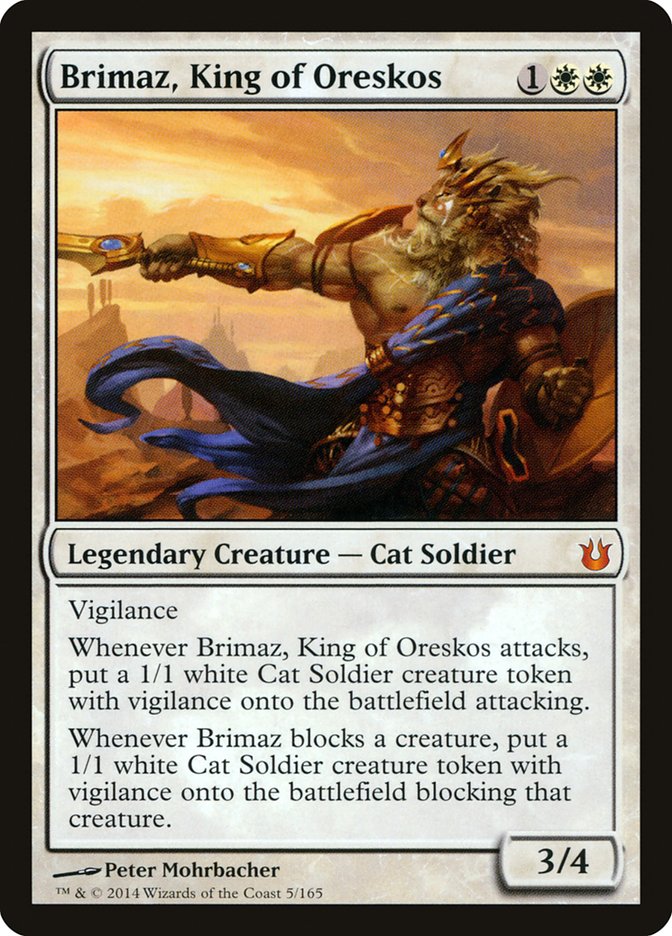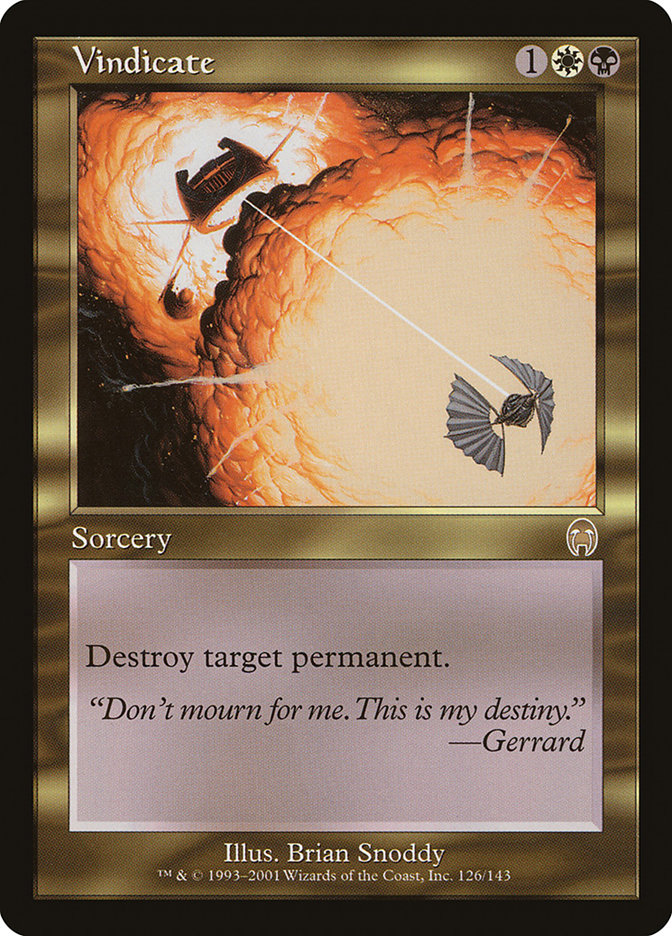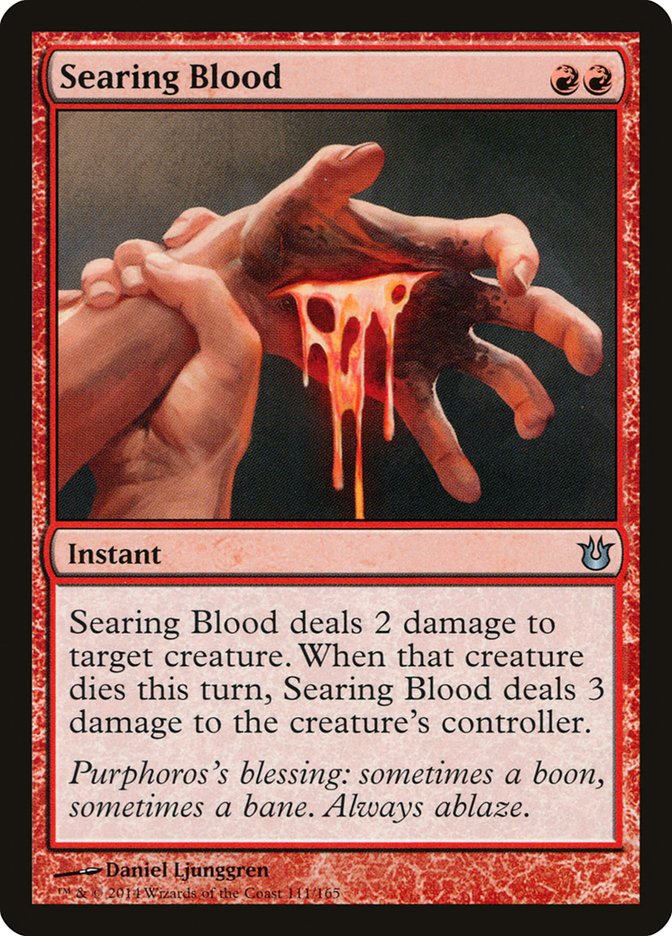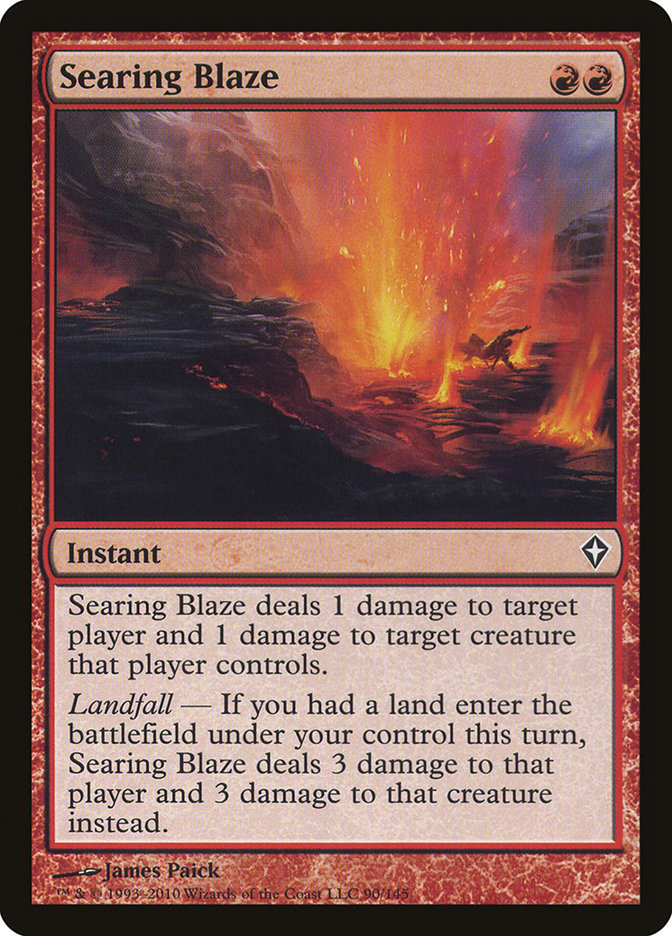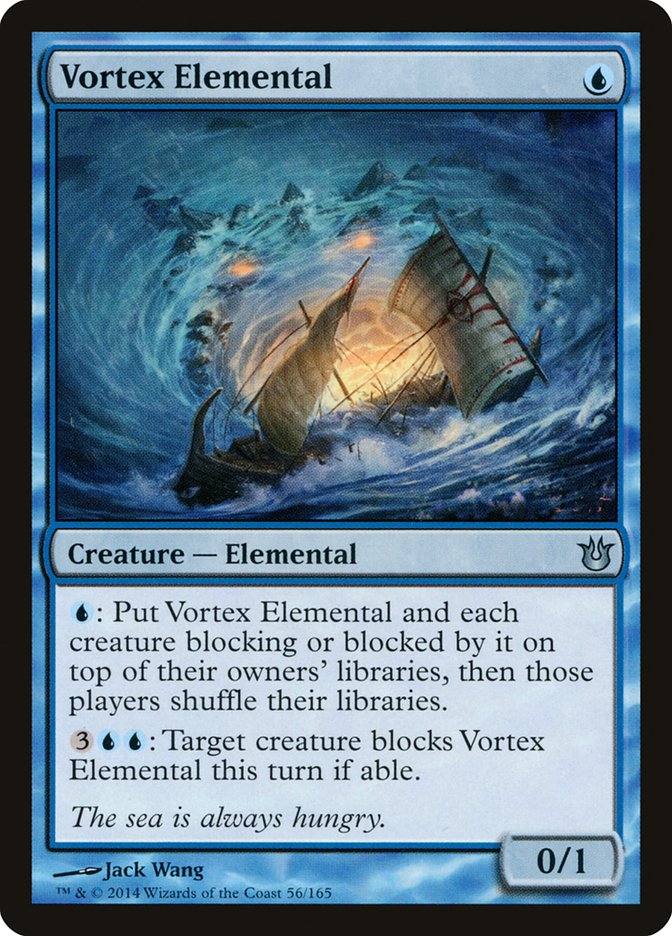If you read my Theros Legacy set review, you know that I’m not riding high on this block’s mechanics. Devotion, bestow, heroic, and newcomers tribute and inspired are all oriented toward creatures, specifically creatures that attack and block. At their core, they’re about investing a lot of mana—and in some cases, cardboard—into the idea that a bigger creature can be a better creature.
Devotion’s siren call offers to pay you off for colored mana symbols—a commodity you didn’t even know you could monetize. Bestow encourages you to build a multitalented behemoth. Heroic asks you to play with a lot of targeted non-removal spells. Tribute offers your opponent a choice between letting you have a huge creature or a smaller creature with a nifty ability. Inspired encourages you to attack with your creatures, promising a reward for navigating your troops through combat.
Legacy is a format geared toward resource exchanges—my Wasteland for your Underground Sea, my Lightning Bolt for your Deathrite Shaman, my Daze for your Dark Ritual, my Smallpox for your True-Name Nemesis. Set mechanics in Theros are synergy driven rather than rate driven—you aren’t getting a great deal for any one item, but if you buy three today, you can get the value of five. Legacy rarely gives you the time to buy three metaphorically speaking.
An example of this is Master of Waves. What a perfect fit—Merfolk is a Legacy deck, a lot of good Merfolk cost UU, and Master of Waves even has protection from Lightning Bolt. So what went wrong?
Well, sometimes you don’t have four mana. Sometimes you don’t have any other creatures in play. Sometimes you have all of those, but they have Swords to Plowshares. Sometimes none of that happens, but then they Show and Tell in Sneak Attack, activate it twice, and attack for 22 in the air. Sorry about all those 2/1 Elementals.
In truth, you’d be better served with Sower of Temptation—now that’s a four-drop with an ability! It solves problems you have—huge creatures and getting killed by Tarmogoyf—rather than problems you don’t have. Merfolk has never struggled with how to break a board stall. Merfolk have Islandwalk. Legacy decks play blue. Blue decks need Islands. Attack them.
With that in mind, let’s look to Born of the Gods—a set created in a similar vein as Theros—for cards that play well regardless of their supporting cast. We’re on the hunt for objective power, not "do something if you have infinite devotion" or "here’s a mediocre creature that gains value through being cast as an Aura first!" No sir, no ma’am—we’re here for the standalone home runs. What have we got?
Well, yes. Spirit of the Labyrinth is a bona fide Legacy playable. I spilled no shortage of digital ink telling you to play these in everything from Death and Taxes to Four-Color Zoo to anything that wants both discard spells and white creatures. See, Thalia, Guardian of Thraben wants to kill them before they can play all of their cards. Thalia has about as much synergy with Thoughtseize as Stifle has with Hymn to Tourach—they work on competing axes of resource denial. At some point you have to decide if you want them to die with five cards in hand or zero cards in hand. If it’s zero, Spirit of the Labyrinth is your go to. If it’s five, play Thalia, Guardian of Thraben.
Lest I leave you without some sort of metagame insight, be aware that a real incentive to play Elves is its great matchup against Death and Taxes. Death and Taxes is excellent against much of Legacy’s top tier, Elves is good against Death and Taxes, and so Elves is a decent deck to choose if you want to win a tournament—just ask Julian Knaab, winner of the 2013 Bazaar of Moxen who defeated Death and Taxes in the finals (you can read both parts of his fantastic report here and here). I want to point out that Spirit of the Labyrinth shuts down Glimpse of Nature in a timely manner, letting you focus on attacking them and deploying Aven Mindcensor in response to Green Sun’s Zenith or Natural Order.
From the same color that brought you a three-power two-drop, Born of the Gods is also primed to deliver an impactful four-power three-drop. Let’s talk about Brimaz, King of Oreskos:
From a cursory reading of the card, we see a three-drop that wins a fight with Nimble Mongoose, can’t block Insectile Aberration, gets eaten by a Batterskull equipped Germ token, faces off against True-Name Nemesis and gains advantage every turn, can’t be Lightning Bolted off of the board, and can’t be killed by Liliana of the Veil unless she shows up right on time.
Oh, and Brimaz attacks for four, then five, then six damage against a combo player. If you have turn 2 Spirit of the Labyrinth, turn 3 Brimaz, King of Oreskos, and literally anything on turn 4, a combo player is dead on turn 5 without the ability to Brainstorm or Ponder their way to victory.
The obvious starting point for Brimaz, King of Oreskos is as a replacement for Mirran Crusader. They perform similar functions—much damage, very combat, wow—but Mirran Crusader can’t fight through True-Name Nemesis. Since I didn’t provide a discard-oriented white aggro list in my Spirit of the Labyrinth article, let’s talk about that right now.
Several commenters on the Spirit article asked about a W/B strategy incorporating Spirit and discard spells. I’ve encountered a lot of W/B aggro-midrange lists in my day, and all of them had the exact same problem:
Too many twos.
Seriously, though, look at your options:
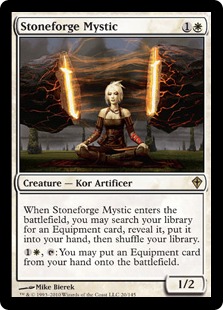
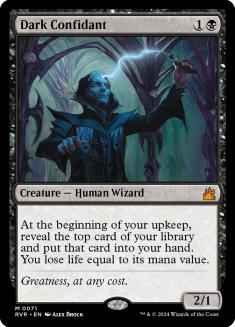
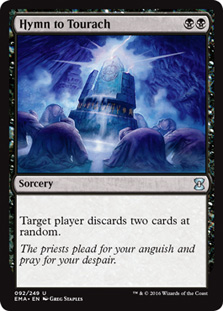
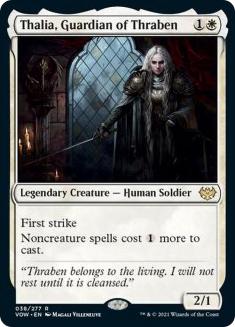
That’s not even getting into black-dedicated options like Sinkhole and Smallpox (with Flagstones of Trokair and Bloodghast!) and white-dedicated options like Serra Avenger. There is an embarrassment of riches at two for W/B homebrewers.
The problem is that Magic is a game that encourages players to play spells of varying casting costs so as to maximize resource efficiency over the course of the game. You can’t just shove sixteen two-drops into your deck and think that playing a two-drop every single turn of the game isn’t going to hurt you.
One thing that really excites me about playing W/B in Legacy? This little number:
Vindicate, along with Brimaz, gives you a respectable three slot. From there we just have to play the best black and white one-drops that the game has to offer and:
Creatures (23)
- 4 Mother of Runes
- 4 Dark Confidant
- 4 Stoneforge Mystic
- 4 Deathrite Shaman
- 3 Brimaz, King of Oreskos
- 4 Spirit of the Labyrinth
Lands (23)
Spells (14)
Sideboard

The sideboard is probably too ambitious and off the mark in some other ways, but I wanted to outline some general ideas I had about the deck in specific terms.
Let’s start with a slot-oriented paradigm. This is a deck that plays four Swords to Plowshares and four Mother of Runes in the starting 60. It wants a lot of anti-combo cards to sideboard in for its relatively weak white spells. Hymn to Tourach, Duress, and Armageddon may not be the best choices and those may not be the right numbers, but I know that you want more discard spells and some kind of haymaker that can put a game out of reach for a combo player who is low on cards and trying to assemble a win via their draw steps.
Speaking in specific terms, Duress is desirable primarily because it’s a one-mana discard spell that lets us bridge into Spirit of the Labyrinth. The games where we have turn 1 discard, turn 2 Spirit are our best possible openings against a lot of decks, so giving us more ways to make that happen is a great way to have more impactful Spirits.
Zealous Persecution is a great card in any Legacy sideboard, but it has to be at its best here. This is a deck that makes 1/1 tokens and automatically puts them into combat—what better card to have than Zealous Persecution to destroy people’s blocking assignments? The upside of killing True-Name Nemesis and Mother of Runes and most of the Elves deck is incidental but obviously appealing.
Reanimate is almost certainly too cute, but it’s worth remembering that Reanimate isn’t just for your own creatures. The slot started out as Surgical Extraction or Extirpate, but eventually it became obvious that such a low-impact plan was doomed from the beginning. You may Surgical Extraction someone’s Bridge from Belows, but they’ll still beat you with Ichorids. You may Surgical Extraction someone’s Griselbrands, but they can still Show and Tell an Elesh Norn, Grand Cenobite or an Iona, Shield of Emeria.
This deck plays a lot of discard spells after sideboarding against combo decks. Why not try to mise their Griselbrand? If they Faithless Looting and discard one dredger, why not try to Reanimate it? The worst thing that can happen is that they have Street Wraith, and you probably weren’t winning that game anyway. Obviously, Reanimate is also gas with your entire creature base, so it could also just act as extra resiliency in an attrition-heavy matchup. Again, it’s probably a stretch, but I’ve always loved a Reanimate that doesn’t target one’s own Griselbrand.
Armageddon is just great in any creature heavy, medium disruption, discard interactive decks where both players end up peeling—the hero for a way to slam the door, the villain for a way to even the score. If your opening hand has Armageddon, you can sculpt the game around binning everyone’s lands while ahead on board—you know, the classic White Weenie Armageddon.
It’s pretty awesome that Brimaz, King of Oreskos beats True-Name Nemesis in a heads-up post-Armageddon showdown. Next time bring friends.
Moving on from the powerhouse that is white creatures in Legacy . . .
Seriously, though, who could have predicted someone would be typing that sentence about Legacy in 2010? We’ve come a long way.
The rest of the set looks pretty barren. Let’s talk about the pros and cons of Searing Blood since we have some time.
From the creators of Searing Blaze . . .
Comes another card that kills their creature and Lava Spikes them! How do we figure out which card is better?
Searing Blood is an objectively more powerful card than Searing Blaze. It does not care whether you played a land this turn or have a fetch land up—it always kills Deathrite Shaman and always deals three to them. That’s a pretty big upside so far.
Contextually, Searing Blaze improves from the density of fetch lands in Legacy mana bases and the relative ease of holding a land in a deck that’s interested in casting Searing Blood. When every deck has eight to twelve fetch lands, you’re kind of a favorite to trigger landfall no matter if you’ve played a land this turn or not.
Unlike Searing Blood, Searing Blaze offers a "deal three guarantee," which is basically the Patrick Sullivan version of the discount double check. If they don’t have a creature that you can kill, you still want your burn spell to nug them for three. Searing Blaze checks that box; Searing Blood doesn’t. That’s a pretty significant drawback.
Where Searing Blood really misses though is in arcane rules hibbledy-bibbledy. Let’s take a look at Searing Blood again:
It has one target. It targets their creature. If their creature dies—which doesn’t always happen remember—they take three.
Searing Blaze . . .
Has two targets. It targets a player and a creature that that player controls. If I Searing Blaze your Tarmogoyf and you Swords to Plowshares it in response, you still take three. This is because a spell with multiple targets will still resolve as much of its text as possible if any of its targets are still valid. If all of a spell’s targets become invalid, it fizzles.
If you Plow your own Deathrite Shaman in response to a Searing Blood, you don’t take three damage.
If you Plow your own Deathrite Shaman in response to a Searing Blaze, you do take three damage.
And that, ladies and gentlemen, is why Searing Blood isn’t going to see play in Legacy.
Last on our short list of Born of the Gods cards for Legacy is Vortex Elemental.
I want to talk about Vortex Elemental because it does something for blue decks that they haven’t been able to do up until now—kill shroud creatures, hexproof creatures, and Tarmogoyfs. Sure, this bugger is fragile as all get out, but people don’t play cards like Izzet Staticaster in Legacy—if someone wants to kill Vortex Elemental, they’re going to use a real Lightning Bolt or Swords to Plowshares to do it. If they don’t want to do that, they’re going to lose one of their ground pounders to the little Elemental that could.
I’m not saying that Vortex Elemental is going to rip a hole in the fabric of Legacy and that mono-blue decks are taking over, but think about it. White has Swords to Plowshares. Red has Lightning Bolt. Black has Innocent Blood and a million two-mana removal spells. Green has Tarmogoyf. Blue is actually pretty soft to a big ground pounder like Tarmogoyf, like Batterskull, like Brimaz. Having access to a card that actually trades for those cards and Nimble Mongoose to boot could be a real boon for certain decks.
Then again, maybe it’s just a 0/1 for U. But that’s why we play the games.
I’ll be back on Thursday with those Dredge videos that I promised last week. Spoiler Alert: People still don’t play enough graveyard hate.

